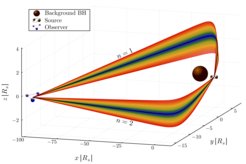How does strong space-time curvature affect the propagation of gravitational waves?
When massive compact objects merge, they emit gravitational waves: distortions of space geometry that propagate through space at the speed of light. Since the first detection of gravitational waves in 2015, gravitational-wave detectors have observed 91 mergers of binary black holes, neutron stars, and mixed binaries. More than 130 candidates are currently under investigation. Scientists have now studied what happens when two stellar-mass black holes merge near a more massive black hole. They have calculated how strong space-time curvature modifies the gravitational waveforms and how this might be detected in future observations.

Paper abstract
Wave packets propagating in inhomogeneous media experience a coupling between internal and external degrees of freedom and, as a consequence, follow spin-dependent trajectories. These phenomena, well known in optics and condensed matter physics, are referred to as spin Hall effects. Similarly, the "gravitational spin Hall" effect is expected to affect the propagation of gravitational waves on curved spacetimes. In this general-relativistic setup, the curvature of spacetime acts as impurities in a semiconductor or inhomogeneities in an optical medium, leading to a frequency- and polarization-dependent propagation of wave packets. In this letter, we study this effect for strong-field lensed gravitational waves generated in hierarchical triple black hole systems in which a stellar-mass binary merges near a more massive black hole. We calculate how the gravitational spin Hall effect modifies the gravitational waveforms and show its potential for experimental observation. If detected, these effects will have profound implications for astrophysics and tests of general relativity.












